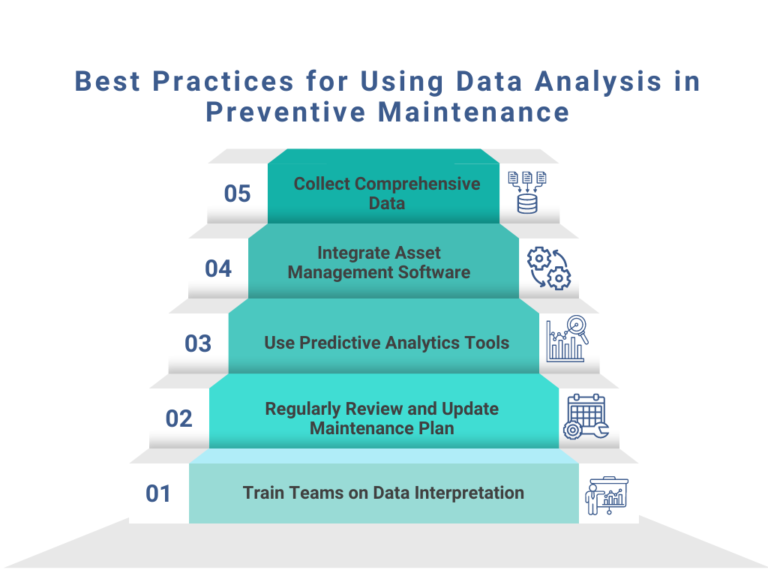Preventive maintenance has become increasingly crucial in modern industrial and commercial settings. It has a significant impact on equipment reliability, downtime reduction, and operational optimization.
Data analysis is profoundly transforming the management of preventive maintenance and the tracking of asset service history. It offers businesses new levels of insight, efficiency, and precision.
Let’s explore the role of data analysis in asset management and maintenance.

Preventive maintenance is a proactive asset service management strategy. It uses data analysis in asset management to prevent equipment failures and ensure optimal performance. It does so by performing regular, scheduled inspections, servicing, and repairs.
Instead of waiting for equipment to fail and then addressing the issues reactively, preventive maintenance systematically maintains assets before problems arise. This minimizes equipment breakdowns and helps avoid costly downtime.
Preventive maintenance relies on a systematic process involving scheduled tasks to ensure that assets remain in optimal condition.
Here’s how it works:
Accurate and detailed asset service history is fundamental to effective asset management.
It informs decision-making, optimizes maintenance schedules, improves resource allocation, and enhances compliance and safety. It also supports long-term asset management and facilitates knowledge transfer.
By maintaining comprehensive records, organizations can ensure that their preventive maintenance routines are well-planned and efficient. They can also ensure that these practices align with the actual needs and conditions of their assets.
Data analysis in asset management has become a pivotal tool to optimize preventive maintenance. It transforms how organizations plan and execute their maintenance activities.
Data analysis leverages historical performance data and real-time insights from sensors and IoT technology. As a result, it enables predictive maintenance, forecasting potential failures before they occur.
This proactive approach doesn’t rely on fixed intervals. Instead, it optimizes maintenance schedules by actual equipment usage and performance trends.
Here are different types of data that help optimize maintenance:
Analyzing this data plays a crucial role in improving decision-making for maintenance scheduling and asset management. It helps forecast when equipment is likely to fail.
This allows maintenance teams to schedule interventions just before issues occur, reducing the risk of unexpected breakdowns and minimizing downtime.
Maintenance optimization involves enhancing maintenance strategies to ensure that equipment operates at peak efficiency while minimizing costs and downtime. It focuses on scheduling and executing maintenance tasks in a way that maximizes asset performance and longevity.
Data analysis is essential for this. It helps optimize maintenance by improving both the timing and execution of preventive maintenance tasks
Here’s how data-driven insights benefit companies:
Asset service history is the comprehensive record of all maintenance, repairs, and part replacements of a specific asset over its lifecycle. This record typically includes detailed information about each service event, such as:
Data on service history provides invaluable insights into asset performance over time. As a result, it offers actionable insights that enable businesses to enhance their asset management strategies:
Predictive maintenance is an advanced extension of preventive maintenance. It leverages real-time data and predictive analytics to enhance asset service management strategies.
Traditional preventive maintenance schedules maintenance tasks at regular intervals regardless of the asset’s condition. However, predictive maintenance focuses on anticipating failures before they occur using actual data.
Here’s how predictive maintenance uses historical data and IoT-enabled sensors:
This offers field service companies several benefits:
Here are some best practices for effectively utilizing data analysis in asset management:

Leveraging data analysis to enhance preventive maintenance and manage asset service management is not just a strategic advantage. It’s a necessity.
The integration of real-time data from IoT sensors with historical service records allows businesses to move beyond traditional maintenance approaches. As a result, they can embrace a more proactive and data-driven strategy. This minimizes unexpected downtime, reduces maintenance costs, and extends the life cycle of assets, all while improving overall operational efficiency.
Looking for a reliable solutions partner to enhance your preventive maintenance strategies?
Schedule your demo with FieldEquip, a leading field service asset management software, and get started today.
Would you like to have a free demo or have any questions about FieldEquip?
US Corporate Headquarters 1011 S. Hwy. 6, Suite 117 Houston Texas 77077 US